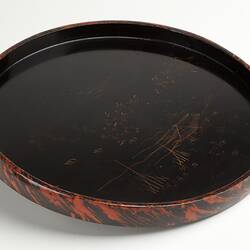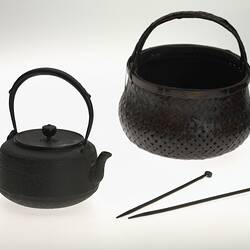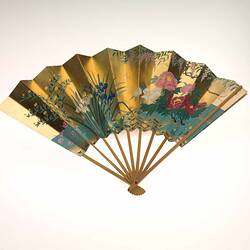Summary
One of two black Urushi lacquerware trays purchased by Kino Hiraga when she was married in Japan 1918 and given by her to her daughter Masumi Hiraga Jackson when she migrated to Australia in 1985.
Masumi Hiraga Jackson was born in Nirasaki, Japan in 1935, one of ten children. Her mother Kino was a skilled weaver who wove and sewed silk kimono, a highly regarded skill. Masumi studied at universities in Tokyo (Japanese cultural studies) and Canberra (English and linguistics) and in 1984 married an Australian. She immigrated to Melbourne in 1985 but sadly her husband died two years later. Masumi decided to remain in Australia and immersed herself in traditional Japanese cultural practices such as Noh theatre, Ikebana and Shimotske paper doll-making. She performs and instructs these art forms in Australia and overseas, and returns to Japan every year to see her family, undertake Ikebana lessons, practise her Noh performance and to purchase materials for doll-making.
Physical Description
One of two circular black lacquerware trays housed inside a cardboard box. Tray is the larger size of the set, and features a painted line drawing of a Japanese garden on the face of the tray, against a black background. The rim edge of the tray features a black marbled surface.
Significance
The significance of this item is its place within a collection which represents the personal and cultural value of maintaining cultural and artistic traditions within a new environment. The act of migration has profound implications for both immigrant and receiving country, with many migrants actively finding ways to introduce their cultural practices in an environment unfamiliar with such activities. This collection can help to explore the successful shift in Australian government policies from the cultural assimilation of the 1950s to the more broadly embracing multicultural policies from the 1970s. Moreover, its significance also lies in the intrinsic artistic value of the finely crafted Shimotsuke dolls, and the cultural heritage value of the collection of kimono.
More Information
-
Collection Names
-
Collecting Areas
-
Acquisition Information
Donation from Mrs Masumi Hiraga, 21 Mar 2007
-
Original Owner
-
Past Owner
Mrs Masumi Hiraga, Melbourne, Greater Melbourne, Victoria, Australia, 1985-2007
-
Classification
Cultural identity, Ethnicity - cultural practices, Food & drink production
-
Category
-
Discipline
-
Type of item
-
Overall Dimensions
2.5 cm (Height), 26.5 cm (Outside Diameter)
-
Keywords




